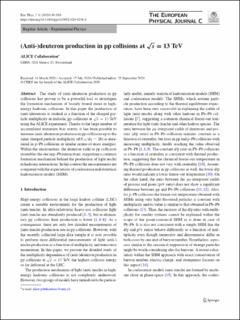(Anti-)deuteron production in pp collisions at √s=13TeV
Acharya, Shreyasi; Adamová, Dagmar; Adler, Alexander; Adolfsson, Jonatan; Aggarwal, Madan M.; Aglieri Rinella, Gianluca; Agnello, Michelangelo; Agrawal, Nikita; Ahammed, Zubayer; Ahmad, Shafiq F.; Alme, Johan; Altenkaemper, Lucas; Djuvsland, Øystein; Eikeland, Viljar Nilsen; Ersdal, Magnus Rentsch; Fionda, Fiorella Maria Celeste; Grøttvik, Ola Slettevoll; Lofnes, Ingrid Mckibben; Nystrand, Joakim; Rehman, Attiq Ur; Røhrich, Dieter; Tambave, Ganesh Jagannath; Ullaland, Kjetil; Wagner, Boris; Yang, Shiming; Yuan, Shiming; Zhou, Zhuo; Arsene, Ionut Cristian; Dordic, Olja; Lardeux, Antoine Xavier; Mahmood, Sohail Musa; Malik, Qasim Waheed; Neagu, Alexandra; Richter, Matthias; Røed, Ketil; Skaali, Toralf Bernhard; Tveter, Trine Spedstad; Wikne, Jon Christopher; Helstrup, Håvard; Hetland, Kristin Fanebust; Kileng, Bjarte; Nesbø, Simon Voigt; Storetvedt, Maksim Melnik; Langøy, Rune; Lien, Jørgen André; Ahn, Sang Un; Akindinov, Alexander; Al-Turany, Mohammed; Alam, Sk Noor; De Albuquerque, Danilo Silva; ALICE, Collaboration
Peer reviewed, Journal article
Published version
Permanent lenke
https://hdl.handle.net/11250/2739245Utgivelsesdato
2020Metadata
Vis full innførselSamlinger
- Institutt for mikrosystemer [546]
- Publikasjoner fra CRIStin [3623]
Originalversjon
Acharya, S., Adamová, D., Adler, A., Adolfsson, J., Aggarwal, M. M., Aglieri Rinella, G., . . . Zurlo, N. (2020). (Anti-)deuteron production in pp collisions at √s=13TeV. The European Physical Journal C, 80. https://doi.org/10.1140/epjc/s10052-020-8256-4Sammendrag
The study of (anti-)deuteron production in pp collisions has proven to be a powerful tool to investigate the formation mechanism of loosely bound states in high-energy hadronic collisions. In this paper the production of (anti-)deuterons is studied as a function of the charged particle multiplicity in inelastic pp collisions at s√=13 TeV using the ALICE experiment. Thanks to the large number of accumulated minimum bias events, it has been possible to measure (anti-)deuteron production in pp collisions up to the same charged particle multiplicity (dNch/dη∼26) as measured in p–Pb collisions at similar centre-of-mass energies. Within the uncertainties, the deuteron yield in pp collisions resembles the one in p–Pb interactions, suggesting a common formation mechanism behind the production of light nuclei in hadronic interactions. In this context the measurements are compared with the expectations of coalescence and statistical hadronisation models (SHM).

